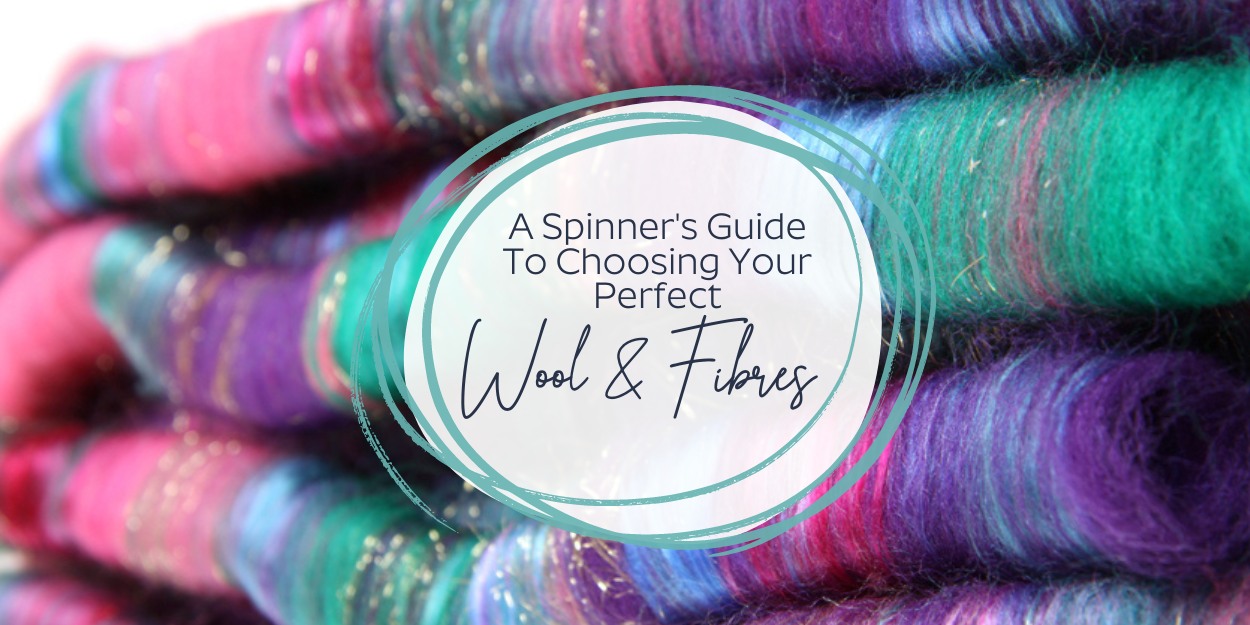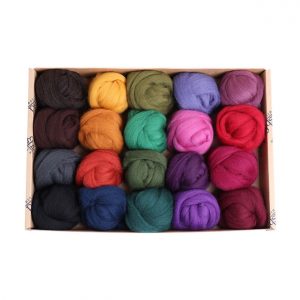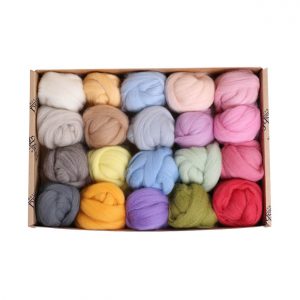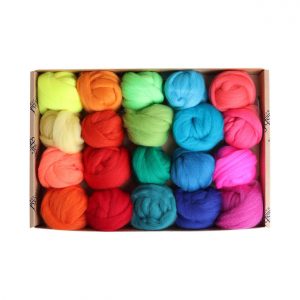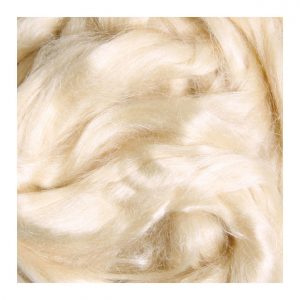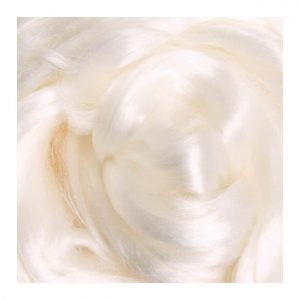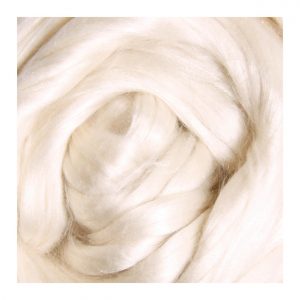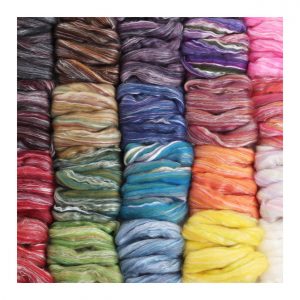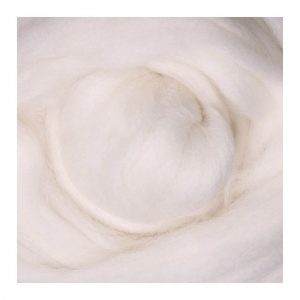Choosing Your Fibres and Wool for Spinning Yarn
So, you’ve decided to embark on the wonderful world of spinning! With a dizzying array of fibres out there, it can be overwhelming to know where to start. Fear not, fellow spinning enthusiast! Whether you’re a seasoned spinner or just beginning your journey, selecting the right fibres can make all the difference in the quality and feel of your finished product. Let’s break down some popular choices and help you find the perfect fibre for your next project.
Merino Wool
Merino is like the superstar of the spinning world! It is sourced from Merino sheep, which are renowned for their fine fleece. It’s super soft, cosy, and drapes beautifully. Spinners love it because it makes yarn that’s both comfy and strong. Once spun into beautiful yarn, you can use it for all sorts of knitting, crochet & weaving projects. Including snuggly jumpers to fancy shawls. Plus, it’s gentle on your skin, making it perfect for baby clothes, booties and beanies! Merino is a versatile choice that will make you fall in love with spinning
Corriedale Wool
If you are just starting out as a beginner spinner looking for a forgiving fibre, Corriedale is a great place to start. Corriedale wool strikes a perfect balance between softness and durability, making it an excellent choice for a wide range of projects. Originating from New Zealand and Australia, Corriedale sheep produce a medium-fine wool that is ideal for both beginners and experienced spinners alike
It’s a hardy wool with a longer staple length, making it easier to draft and spin into even yarn. Corriedale is also known for its bounce and elasticity, resulting in a yarn that’s warm, durable, and full of character.
-
Corriedale Sliver Sample Pack 3 – Darks$110.00 inc GST
-
Corriedale Sliver Sample Pack 1 – Lights$110.00 inc GST
-
Corriedale Silver Sample Pack 2 – Brights$110.00 inc GST
Alpaca Wool
Alpaca wool is prized for its softness, warmth, and hypoallergenic properties. It’s considered a luxurious fibre as it has a beautiful natural sheen that adds a lovely finish to your handspun yarn. Alpaca fleece comes in a wide range of colours and qualities, from the luxurious and fine Suri alpaca to the stronger and more rustic Huacaya. Unlike sheep’s wool, alpaca fibre contains no lanolin, making it less likely to cause irritation. It’s perfect for winter garments like hats, mittens, and shawls, providing excellent insulation while remaining lightweight.
Alpaca Merino Blend
Combining the best of both worlds, Alpaca Merino blends offer the softness of Merino with the warmth and durability of Alpaca. It’s an excellent choice for high-quality, elegant garments that need to be both beautiful and functional. The blend spins beautifully, allowing you to create yarn with the perfect balance of softness, drape, and elasticity.
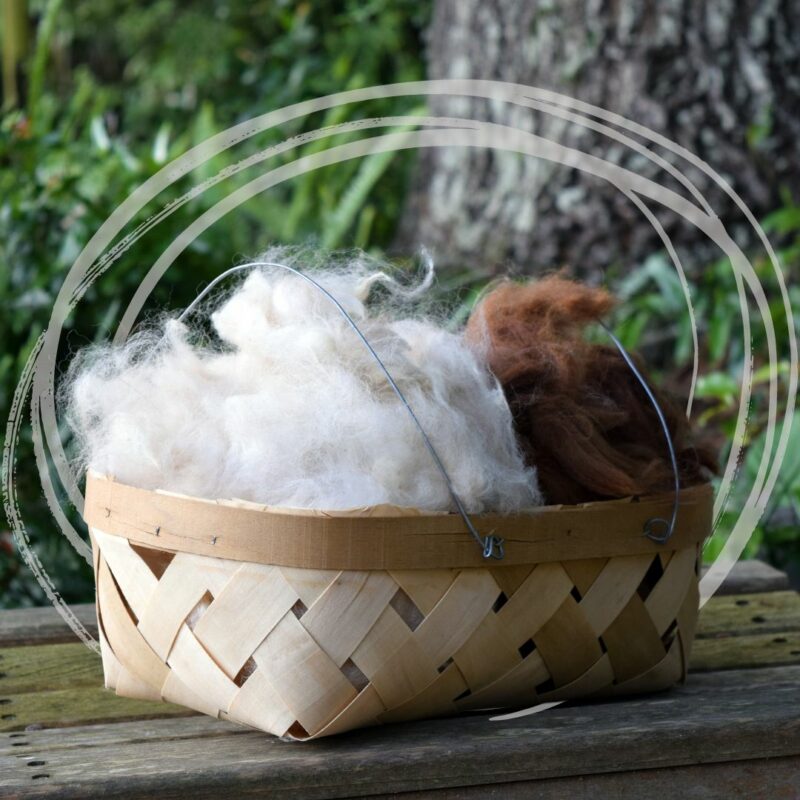
Silk Merino Blend
For a touch of luxury, the Silk Merino blend is hard to beat. This combination brings together the softness and elasticity of Merino wool with the shimmering elegance of silk.This beautiful blend creates a yarn that is incredibly soft and drapey. The silk content adds strength and sheen, while the Merino wool ensures that the yarn remains soft and comfortable against the skin. Silk Merino blends are perfect for delicate shawls, lace garments
Angelina Fibre
If you’re looking to add a bit of sparkle to your spinning, Angelina fibre is the perfect choice. Angelina is a unique and versatile fibre made from polyester. These fine, synthetic fibres come in a variety of colours and can be blended with other fibres for a unique finish. A little goes a long way with Angelina fibre, so you can create subtle highlights or go all out with a full-on sparkle effect.
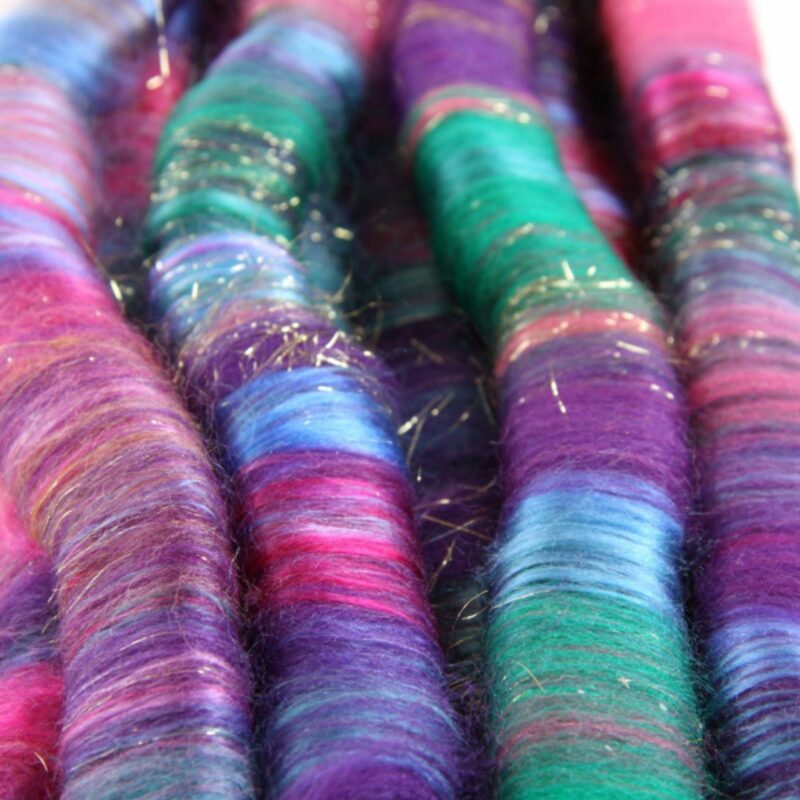
Tussah Silk
Tussah silk is a wild silk that has a unique texture and natural colour variations. Its harvested from wild silkworms and is known for its rich, golden hue. This silk has a slightly coarser texture compared to cultivated mulberry silk, but still offers a wonderful sheen and drape.Tussah silk blends well with wool and other fibres, adding strength and lustre to your yarn.
Linen
Linen is a plant-based fibre that has been used for thousands of years to create durable, breathable textiles. It’s perfect for creating lightweight fabrics, as it has excellent drape. Linen yarns are strong, absorbent, and get softer with each wash. Making them ideal for summer garments. Linen can be challenging to spin due to its uneven staple length, but the results are well worth the effort.
Mulberry Silk
Mulberry silk is the epitome of luxury in the fibre world. It’s incredibly soft, lustrous, and has a delicate drape. Cultivated from silkworms that are fed exclusively on mulberry leaves, it’s the finest silk available. It is known for its uniformity and pure white colour. Mulberry silk spins into a smooth, shiny yarn that drapes beautifully, making it perfect for high-end garments and accessories. Its softness and sheen make it a dream to work with.
Lyocell
Lyocell is a sustainable and eco-friendly fibre made from wood pulp. It is known for its softness, strength, and excellent moisture-wicking properties. Lyocell also blends well with other fibres, making it a great choice for spinning. Lyocell is also biodegradable and environmentally friendly, making it a great choice for eco-conscious crafters.
Merino Lyocell Blend
The Merino Lyocell blend combines the softness and warmth of Merino with the sustainability and drape of Lyocell. Resulting in a yarn that is incredibly soft, strong, and breathable. The Merino wool adds elasticity and warmth, while the Lyocell contributes a silky smoothness and excellent moisture-wicking properties.
Why does choosing the right spinning wool or fibre matter?
Well, imagine trying to bake a cake with the wrong flour! The outcome wouldn’t be quite right. Similarly, using the wrong fibre for your project can affect its warmth, softness, drape, and durability.
Choosing the right type of wool or fibre is crucial for spinning the perfect yarn because each fibre brings its unique properties to the mix.
So, take your time, experiment, and have fun exploring the wonderful world of fibres! With a little knowledge and creativity, you’ll be spinning yarn that’s perfect for your next project.
The key to finding the perfect fibre is to consider the end product you have in mind.
- What qualities are important to you?
- Do you want something soft and warm, or strong and durable? Once you know what you’re looking for, you can start narrowing down your options.
Questions to Ask When Choosing Wool or Fibre
1. What is the spinning, knitting or weaving project I’m planning to make?
- Understanding what you intend to create can guide your fibre choice. Different projects may require different properties in your yarn, such as softness for baby clothes, strength for socks, or warmth for a winter scarf.
2. What level is my spinning skill?
- Beginners might find certain fibres easier to spin than others. For example, longer staple fibres like Corriedale wool are easier to handle than shorter staple fibres like Merino.
3. How soft does the finished yarn need to be?
- Some fibres, like Merino wool or silk blends, are incredibly soft and perfect for garments worn next to the skin. Others, like linen, may be better suited for items where softness is less critical.
4. Do I have any allergies or sensitivities?
- This is crucial for people with sensitivities. If you have sensitive skin or allergies, you might prefer hypoallergenic fibres like Alpaca, which contains no lanolin, or consider plant-based fibres like linen or Lyocell.
5. What characteristics do I want in my yarn (e.g., warmth, durability, sheen)?
- Different fibres offer unique properties. For warmth, Alpaca is a great choice. For durability, consider Corriedale wool. If you want a luxurious sheen, silk blends or Mulberry silk are excellent options.
6. What is the staple length of the wool fibre?
- Staple length can affect the ease of spinning and the durability of the yarn. Longer staple lengths are generally easier to spin and produce stronger yarns, making them good for beginners.
7. What is my budget?
- Fibres range widely in cost. Luxury fibres like Mulberry silk can be more expensive than more common wools like Corriedale or Merino.
8. Do I want a natural or synthetic fibre?
- Natural fibres like wool, silk, and linen offer unique textures and properties, while synthetic fibres like Angelina can add sparkle or other special effects.
9. Do I prefer a blended fibre?
- Blends, such as Alpaca Merino or Silk Merino, can combine the best qualities of multiple fibres, offering a balanced yarn that might be perfect for your project.
10. What is the environmental impact of the fibre?
- If sustainability is important to you, consider eco-friendly options like Lyocell, which is made from sustainably sourced wood pulp and is biodegradable.
11. How much fibre do I need?
- Estimating the amount of fibre required for your project can prevent you from running out mid-way. Patterns often provide guidance on how much yarn is needed, which can help you calculate the fibre amount.
12. What is the dyeing method of the fibre?
- Some fibres are available in natural colours, while others are dyed. Understanding the dyeing process can help you choose colours that won’t bleed or fade over time. We have an introduction to dyeing kit that gives you everything you need to start dyeing your own yarns and fibres
At The Good Yarn, we’re here to guide you in finding the perfect fibres for your spinning needs. If you are looking for some like minded spinners, you will find them in our online craft group here
Happy crafting!

